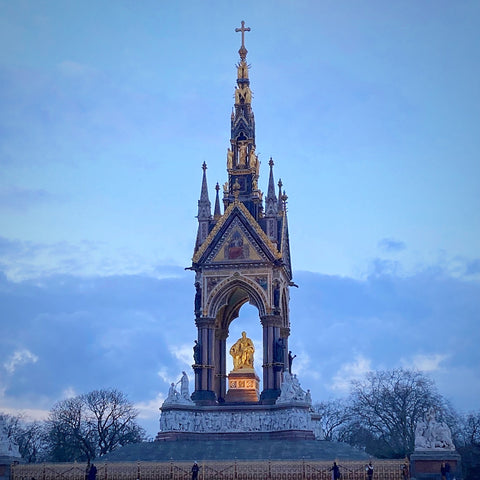
Hyde Park provides much "breathing space" for many Londoners—not unlike Central Park in New York City. The park began in 1536 when Henry VIII plundered the Church property from Westminster Abbey (part of his "dissolution of the monasteries") and created a private hunting grounds for himself and his court. In 1637, King Charles I declared the park open to the general public—and it has since remained an important retreat from the bustle of London's urban life. The park also is a site of dog walking, sunbathing, horseback riding, and other quiet recreation. It has been a military camp, a parade grounds, an exhibition fair grounds and the location for duels to the death. And Hyde Park is a go-to location for protests and to exercise one's free speech (most famously at "Speakers' Corner," where people come to expound of topics close to their hearts—to the cheers and heckling of the assembled crowd).
Shown above, The Serpentine, a 40 acre man-made lake, created in 1730. It is stocked with fish and is used recreationally for fishing, swimming and boating. In fact, the Serpentine was used for a few events in the 2012 Summer Olympics.

Here a small boy rides a dolphin—atop an 1862 Victorian fountain sculpted by Alexander Munro. It can be found in Hyde Park's Rose Garden.

Like in Central Park, long vistas of open space—bordered with a distant tree line or a row of buildings—create a wonderful juxtaposition of "man and nature." Such open space also has a redeeming effect on the stress levels of busy urban dwellers.

In 1851, Prince Albert, husband of Queen Victoria, organized in Hyde Park The Great Exhibition of the Works of Industry of All Nations in a "Crystal Palace"—a temporary cast iron and glass structure of nearly one million square feet of exhibition space housing 14,000 exhibitors from around the world. Although France had previously mounted exhibitions of French industry, this was the first of numerous international World's Fairs (mounted over the next century) which were designed to present the arts, cultures and industrial advancements of different peoples from around the world.
At the Southern edge of Hyde Park stands the Albert Memorial, commissioned by his widow, Queen Victoria, upon Albert's death in 1861. The 175 foot structure was designed by Sir George Gilbert Scott. The tower was completed in 1872 though the central sculpture was not installed until 1876. The sculpture of Prince Albert had been started by sculptor Baron Carlo Marochetti who died in 1867. John Henry Foley continued work on the sculpture, though he, too, died before the sculpture was unveiled. This Prince Albert sits at the Southern edge of Hyde Park (and the City of Westminster), silently observing the goings-on across the street, at the Royal Albert Hall (which he had begun planning before his death, but never lived to see). More about this tomorrow.
Though our Greenwich Village store is now permanently closed, LEO Design is still alive and well! Please visit our on-line store where we continue to sell Handsome Gifts (www.LEOdesignNYC.com).
We also can be found in Canonsburg, Pennsylvania, at The Antique Center of Strabane (www.antiquecenterofstrabane.com).
Or call to arrange to visit our Pittsburgh showroom (by private appointment only). 917-446-4248

